|
Gravesend Road, Gadds Hill
Higham
01634 717104
https://whatpub.com/sir-john-falstaff
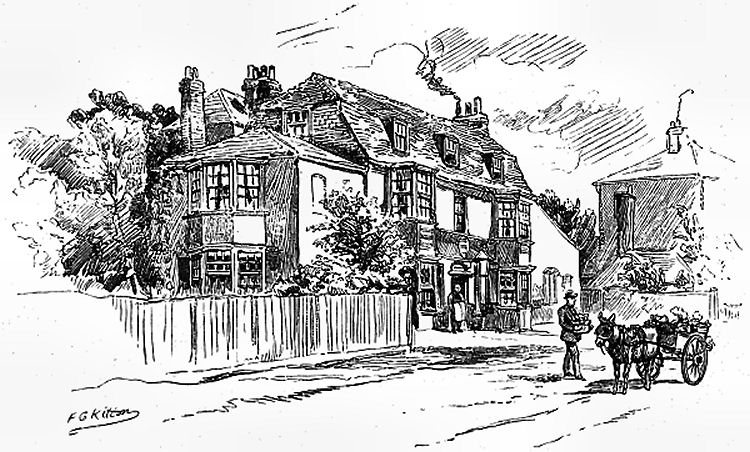
Above drawing, date unknown. |
 Above engraving circa 1895 from the book "The Old Dover Road."
|
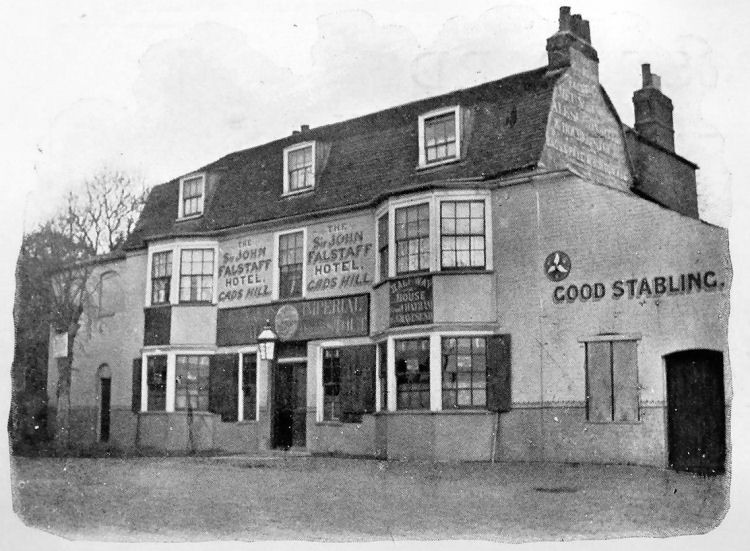
Above photo 1903, kindly submitted by Mark Jennings. |
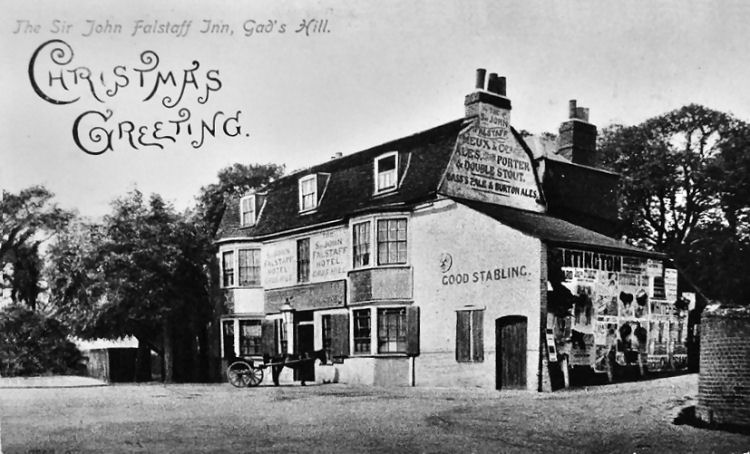
Above Christmas card, 1905, kindly sent by Rory Kehoe. |

Above postcard 1905. |
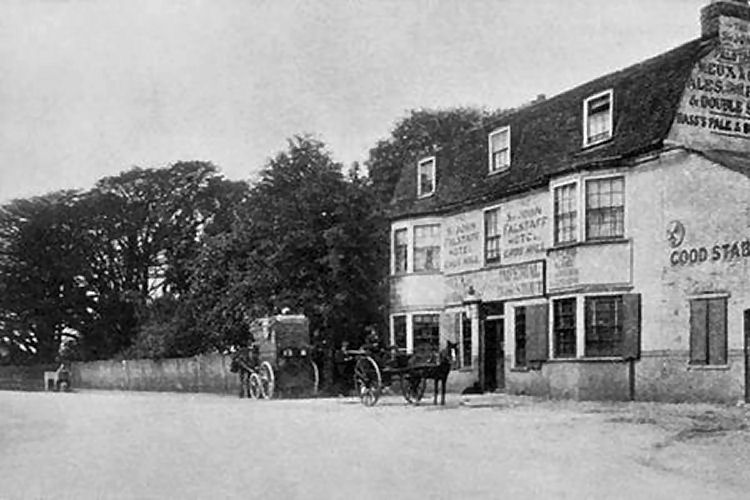
Above postcard, circa 1907. |
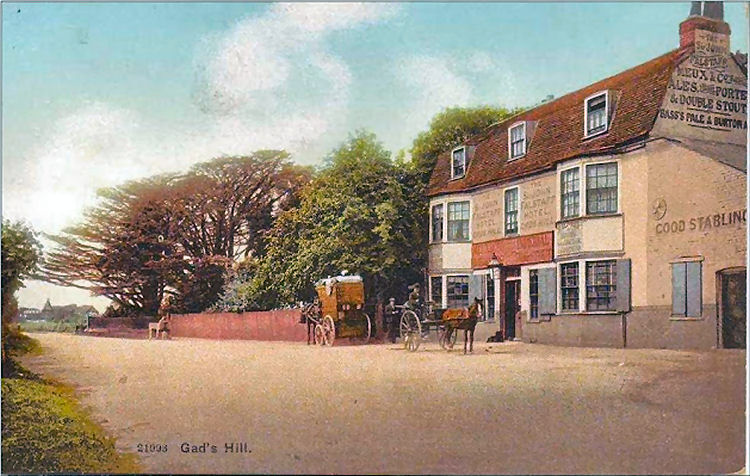
Above postcard 1907, a coloured version of the one above. |
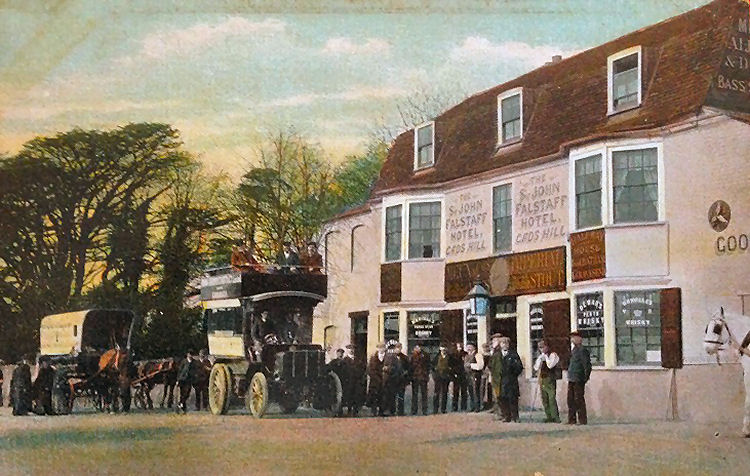
Above postcard, circa 1910. Kindly supplied by Rory Kehoe. |
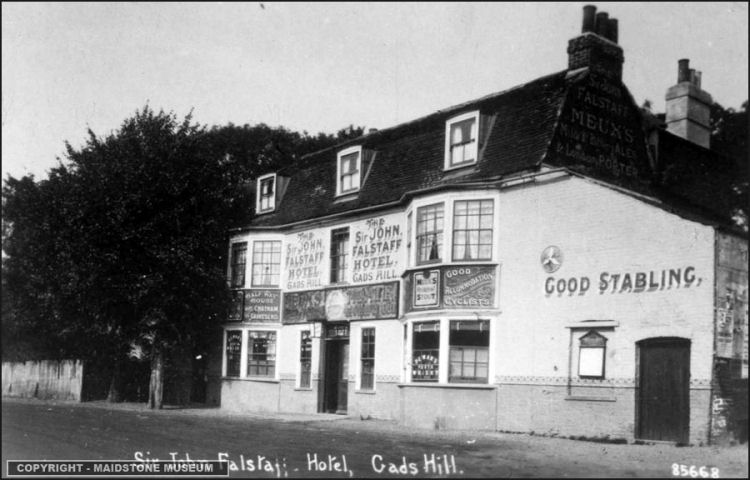
Above photo, date unknown, with permission from Eric Hartland. |
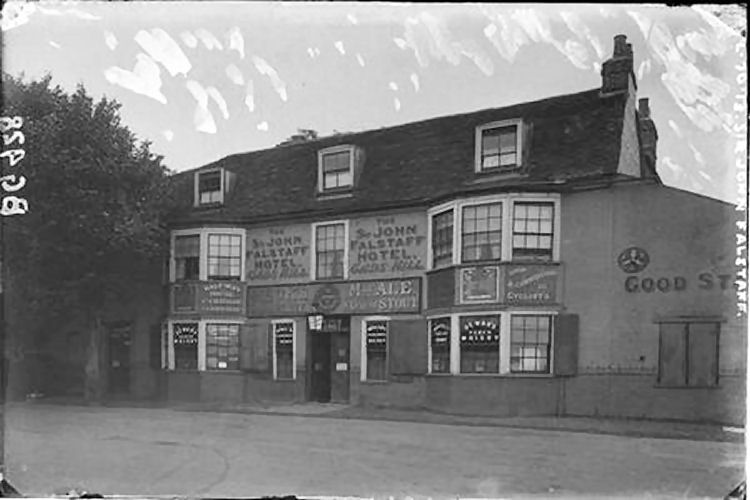
Above photo 1920s, from Medway Council web. |
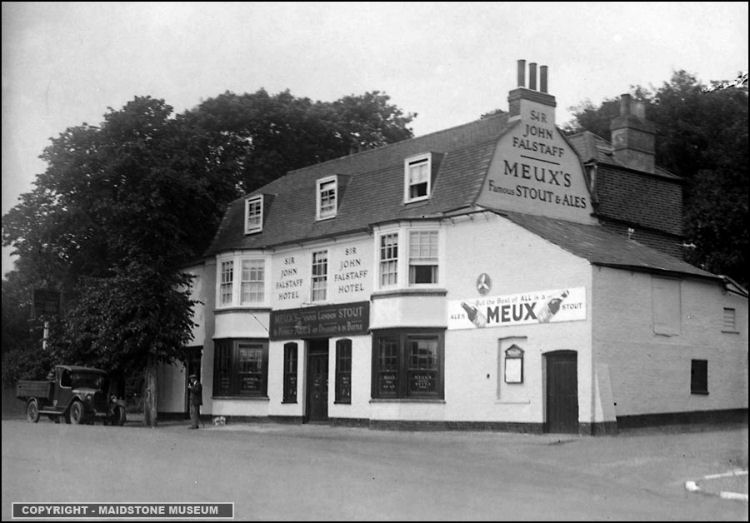
Above photo, date unknown, with permission from Eric Hartland. |
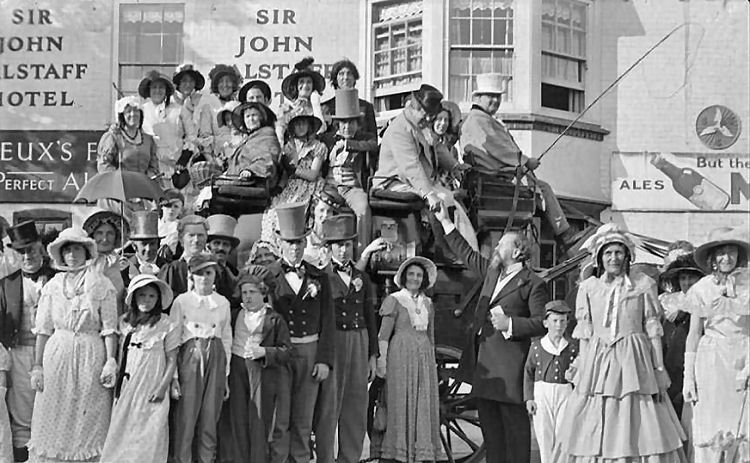
Above photo, 1936. Kindly sent by Rory Kehoe. |
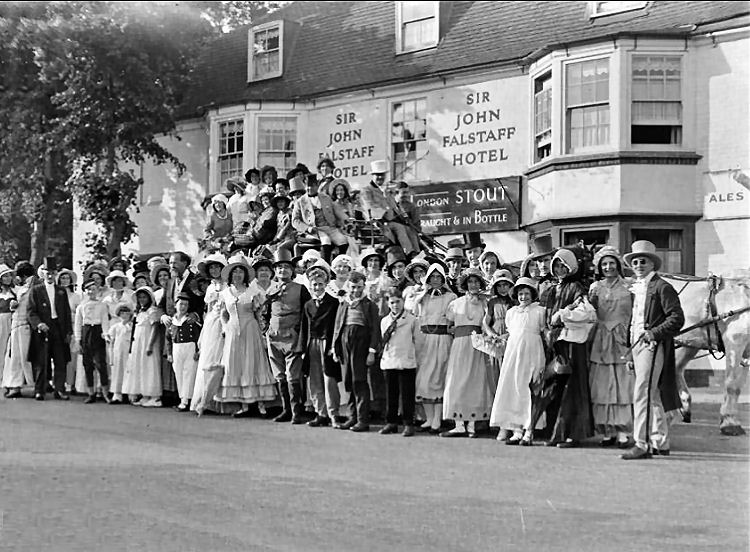 Above photo, 1936. Kindly sent by Rory Kehoe. |
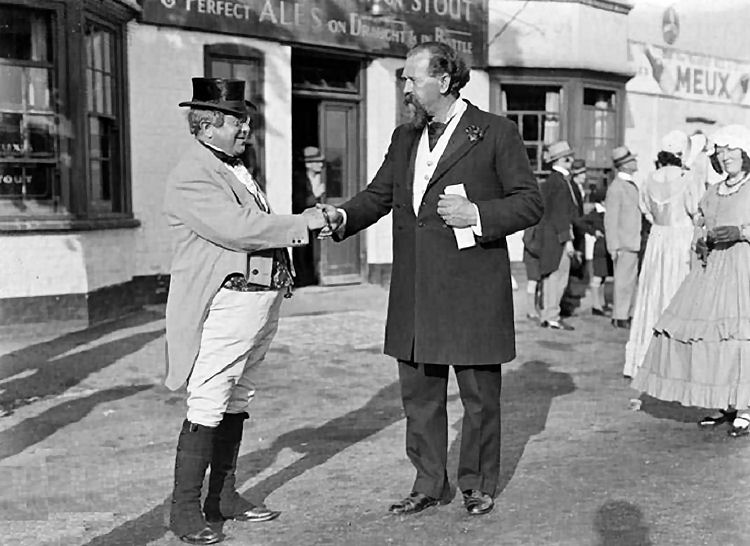
On the 100th anniversary of the publishing of Charles Dickens' Pickwick
Papers, Mr. Pickwick gets the chance to shake the hand of his creator.
Who the principal character actors and costumed extras were, is sadly
not recorded. Charles Dickens, who lived nearby at Gad's Hill House,
described The Sir John Falstaff in his book, The Uncommercial Traveller,
as "a little hostelry, which no man possessed of a penny was ever known
to pass in warm weather." |
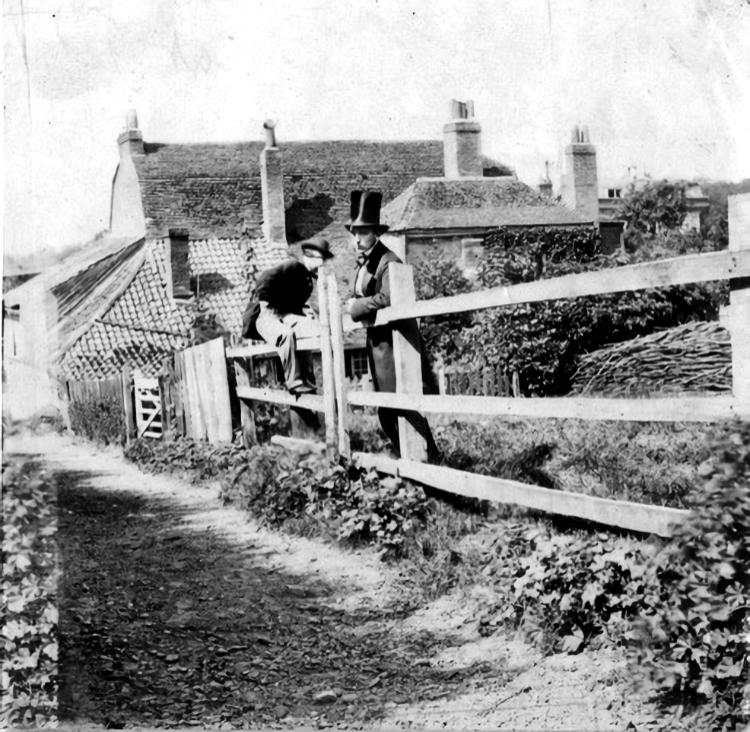
The photo shows Dickens climbing over a fence with his son Francis
standing nearby. Careful scrutiny of the surrounding has led Dr. Leon
Litvak (of the Dickens Letters Project) to deduce that the building
behind Dickens is the "Sir John Falstaff Inn." I also believe the
window, seen in the distance to the right of the chimney, is a window of
Gads Hill Place, Charles Dickens residence.
If this is indeed a photo of Charles and Francis, it must have been
taken prior to Francis leaving for India in 1864. Dr. Litvak says that
Robert Hindry Mason was the only photographer to have visited Gad’s Hill
in 1862 & 1863 and he believes the photo may have been taken in one of
these sessions. If that’s the case, Francis would be 19 years old, going
on 20 which fits the individual in the top hat. Unfortunately it appears
that Dickens moved when the photo was taken and his facial features are
not recognizable.
Kindly sent by C. Ralph Hayes MD. |
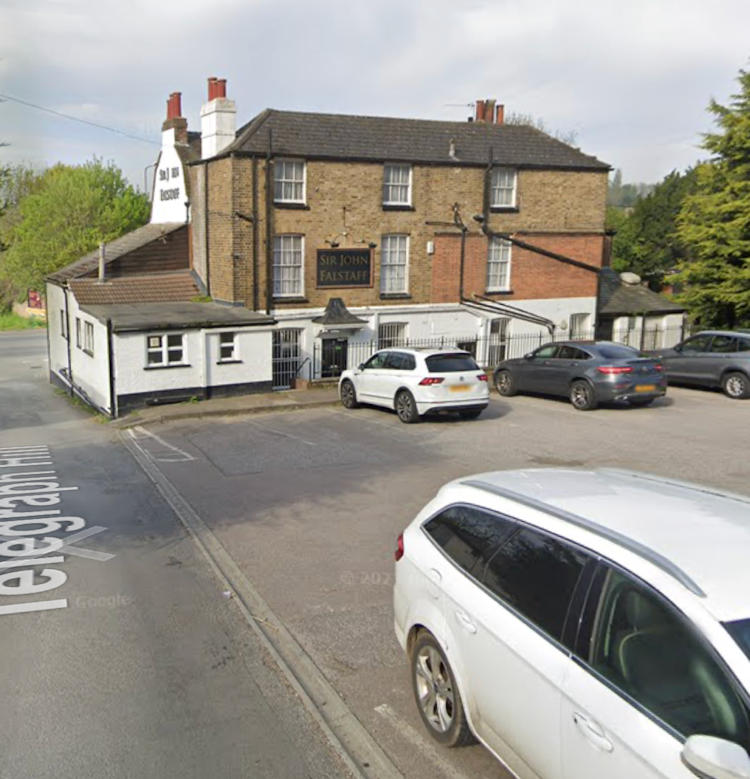
Above Google image May 2023, showing the rough location of the photographer. |
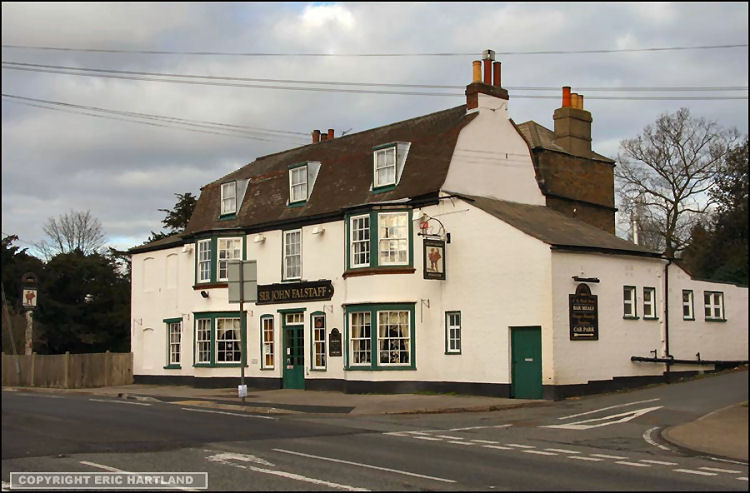
Above photo, date 2008, with permission from Eric Hartland. |
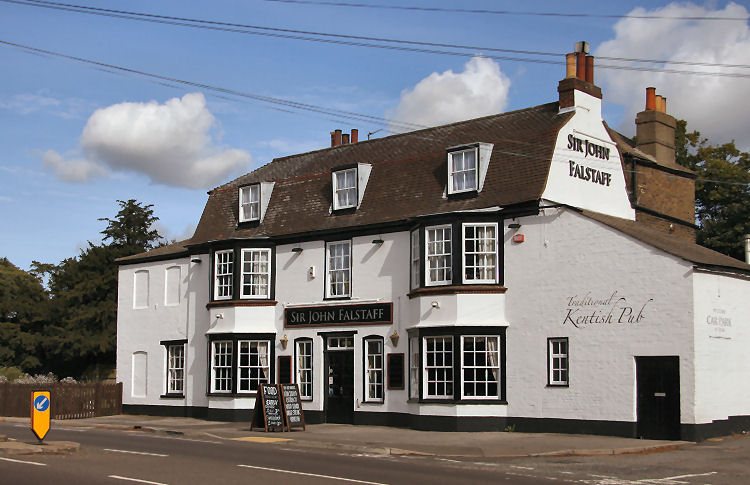
Above photos, 4 October 2009, taken by Eric Hartland. |
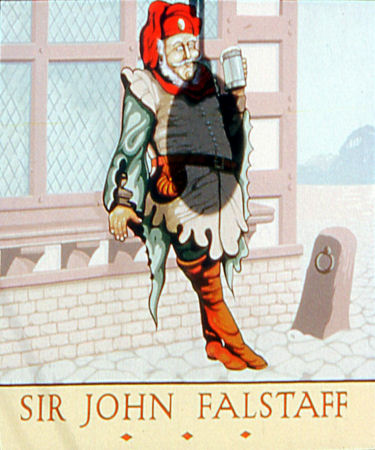
Above sign 1964.
With thanks from Brian Curtis
www.innsignsociety.com. |
 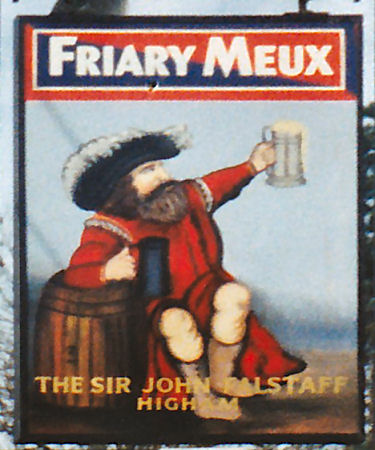
Above sign left, May 1986, sign right October 1986.
With thanks from Brian Curtis
www.innsignsociety.com. |
|
Kentish Gazette, Tuesday 20 August, 1771.
Saturday as Richard Hussey a labourer, who works in Chatham Dock, was
returning from Greenhithe, he was stopped by two men, near the sign of
the "Falstaff" on Gadshill, who robbed him of 4 pence his hat and wig,
and threw him into a ditch. He was soon after taken out by some people
coming that way, almost suffocated.
|
|
Kentish Gazette 17 December 1802.
Chatham Dec. 13.
Thursday last in the afternoon, between 3 and 4 o'clock, as Mr.
Thomas Howell, who keeps a public house at Gravesend, was coming to
Chatham to pay his brewer, he was attacked by two footpads and
coming down Gads-hill near the "Sir John Falstaff," who knocked him
down and beat him in so unmerciful a manner as to break two of his
ribs, and bruising in many other places; they robbed him of £40, and
left him in the road helpless; a returned post-chase going to
Gravesend coming up, the driver saw him lie, and his pocket book
open by him. The boy got him into the chaise and drove him to his
own house, where is he continues dangerously ill.
The next afternoon about the same time, as three men were coming
to Chatham; two of them went into the "Sir John Falstaff" to light
their pipes; one who's pipe was not out, kept walking on; when he
came near the same spot where Mr. Howell was stopped, two men rushed
out of the wood and knocked him down, and one got upon him to rifle
his pockets, they took one pound notes and a few shillings, pulled
hard at his watch but the chain breaking they missed taking it, for
the man's companions coming out saw the circumstance and ran, the
footpads seeing them, left their prey and fled into the wood.
|
|
Canterbury Weekly, 17 December, 1836.
On Sunday afternoon as serious accident occurred near the "Falstaff
Inn," at Higham. A post-chaise belonging to the "Crown Inn," was
proceeding up the road, when a trace broke, and Mr. Whatman, who was
on his way to Gravesend with passengers for the steam-boat's,
offered one of his own to the post-boy, and whilst engaged in
adjusting it he received a severe kick from one of the horses, by
which it is feared some of his ribs are broken, and the hostler at
the same time had an arm broken.
|
|
Kent Herald, 12 June 1845.
On the 2nd instant, an inquest was held at the "Falstaff Inn," Higham, before J.
Hinds, Esq., coroner, on body of Mrs. Nancy Lepine, of Canterbury, widow, age 76
years.
From the evidence of Mr. Wilson, the landlord, it appeared that the deceased to
be taken ill in an omnibus between Rochester and Gravesend, and on arriving at
his house the deceased alighted and went to bed. On the following day she
appeared to be somewhat better, but unable to proceed on her journey. She
retired early to bed the second night, and the next morning was found dead in
her bed.
Mr. Welby, sen., of Canterbury, confectioner, identified the deceased, and
stated that she had left Canterbury the previous Thursday for London, to pay a
visit; she had been taken suddenly ill in church about eight weeks before, and
had long laboured under palpitation of the heart.
The jury returned a verdict of "Died by the visitation of God."
|
|
From the Maidstone Gazette and Kentish Courier, 20th January, 1846.
To be let.
(The present tenant having taken a larger business.)
The "Sir John Falstaff Inn," pleasantly situated on the high road at the
very healthy and celebrated spot, Gads Hill, in the parish of Higham,
Kent, halfway between Gravesend and Chatham, containing 18 rooms, with
good sellers, stable, &c, and a large garden attached. The fittings are
convenient. Coming in moderate.
For further particulars apply to Mr George Wilson, on the premises.
|
|
Morning Advertiser 02 December 1846.
FIRE AT GAD'S HILL.
On Thursday night a fire occurred at the "Sir John Falstaff Inn," Gad's
Hill, near Rochester which fortunately was discovered before it had
attained much power. It appears that a farmer residing in the
neighbourhood, in passing the premises, about ten o'clock, observed a
body of smoke issuing from the stable adjoining the inn. He instantly
raised an alarm, and on the doors being opened the flames burst forth,
and it was with some difficulty that a horse, belonging to Mr. Gregory,
the landlord, was extricated. The flames were then speedily subdued. But
for the fortunate discovery, most probably the whole of the premises
would have fallen prey to the devouring element. The accident arose from
a lighted candle being left in the stable, which communicated with the
straw.
|
|
Kentish Gazette, 23 November 1847.
ALLEGED POISONING NEAR ROCHESTER.
An inquiry, which has occupied Mr. Hinde one of the county coroners, and
a jury, for several days, was brought to a close late on Friday evening,
at the "Falstaff Inn," Gad’s Hill, near Rochester.
The deceased was a healthy woman, and on Tuesday, the 9th of last month,
she was delivered of a child which is still living. Mr. Wiblin, a
surgeon, residing at Strood, attended her. He saw her on Wednesday and
Thursday, and he neither saw nor heard of any unfavourable symptoms. He
considered her to be going on so well that he did not deem it necessary
to call and see her on the Friday. At this period the nurse, Ann Caush,
noticed a remarkable change in her state. She reached violently, and
threw oft her stomach a slimy substance of different colours. During the
day her mother, Mrs. Fisher who is blind and lives in Gravesend, visited
her, and hearing the alarming turn her condition had taken, begged the
husband to send for the doctor. She suffered considerably during the
night in vomiting, and on Mr. Wiblin seeing her he found her in a state
of collapse. She was apparently asleep; he touched her on the shoulder,
and she awoke. He inquired of her whether she had any pain, and she
immediately fell into a state of slumber. He ordered her such medicines
as he deemed advisable and saw her frequently during the day, when she
appeared in the same state. Gruel seemed to have been her principal
nourishment; it was made either by the nurse or Mrs. Fisher, and it
frequently happened that it was left on a hob in the adjoining room,
with no one present, so that any person could mix anything in the gruel
without the attendants knowing it. The nurse generally gave the
unfortunate woman gruel when she required it, but the husband in the
course of the Sunday night helped her to some, which she took. An hour
or so afterwards, her state became more alarming. She was in a state of
frenzy, and had jumped out of bed, and it required all in the house to
prevent her injuring herself. Mr. Wiblin attended her. She was sensible
to a certain extent. She complained of a burning sensation in the
throat, thirst, sickness, and a pain in the region of the stomach. What
was thought proper was given her, but she kept sinking very fast during
the following day, and on the next (Tuesday) morning she expired, at
four o’clock. Previously to this, Mr. Fisher had written to a Mr.
Holmes, an appraiser and undertaker in the London-road, Borough, London,
who was an uncle to the deceased about her mysterious change, and
begging that he would go down to advise her. On reaching Mrs. Fisher’s
residence at Gravesend, on Tuesday morning, Mr. Holmes found the husband
of the deceased there, and heard that she was dead, hearing the
circumstance, he immediately proposed accompanying him to see the
corpse. They accordingly went. As soon as the husband heard of the
parish constable summoning a jury, he decamped, no one knows whither.
The result of the post mortem examination of the body of the deceased
Mr. Wiblin detailed at some length. Externally he saw nothing to cause
death; there was a large bruise on one hip, which was the only external
mark of violence on the body, but it had nothing to do with death.
Internally he found the throat much inflamed, discoloured and swollen;
the stomach and intestines were considerably inflamed; there were recent
ulcerations in the stomach. He took away the throat and stomach, and
after applying the different tests, he discovered the presence of oxalic
acid. He was of opinion that deceased had died from oxalic acid.
The Coroner then at some length summed up the evidence, and alluded to
the remarkable fact that the husband of the deceased leaving his family,
his home, his business his all, the moment an inquest was about being
held.
The jury consulted for a considerable time, and then found a verdict of
Wilful Murder against William Brown the husband.
|
|
The Stage, Thursday 11 November 1976.
Kentish is where the hops really come from. That fact alone makes the
County pubs Country! And pubs are big business on the showbiz front
today. You can forget the idea that down here that all the pubs are
oak-beamed and full of yokels moving at a snail's pace.
Entertainment is IN at the INNS take my word. No, don't take my word
just listen to the people I've been talking to in an in-depth round up.
....
Like the "Falstaff," at Higham, bang opposite the house in which
Charles Dickens lived and died. The old reformist would, I suspect,
approve of the changes in his "local," although he might have found it
difficult to concentrate on writing on Sunday lunch times when a regular
jazz band goes into action.
But then, shouldn't we all put our pens down on a Sunday?
I think I will - and pop out for a ginger ale.
Jimmy Hodge Jnr.
|
The Medway Archives and Local Studies Centre has referenced a set of
documents, that I haven't seen yet, and is part of the Watts Charity MSS,
1579-1972.
Reference is made as follows:-
1851-1858
T39. Premises at Rochester, Gillingham, Frindsbury & Higham [including 2
messuages, High St., St. Nicholas; 3 messuages next to The "Cossack," Delce
Lane; 4 messuages next to the "Royal George," High Street; 1 messuage next
to the "Angel," all in St, Margaret's, Rochester; Quarrington House, High
Street, Gillingham; farm at Frindsbury and Higham; and l messuage near the
"Falstaff," Higham) (1 bundle)
There is some evidence to suggest that the Sir John Falstaff Inn, which
dates from c.1760, was originally located in the building next door, which,
for many years, was a doctor's surgery.
Found at Gad's Hill Place and mentioned in the book "The Old Dover Road"
by Charles G Harper 1895, it is
stated that:- "The pranks of Falstaff and Prince Hal, whose doings were to be
“argument for a week, laughter for a month, and a good jest for ever,” are
commemorated, in a fashion, by a large roadside inn, the “Falstaff,”
standing nearly opposite Gad's Hill Place, the successor, built in the time
of Queen Anne, of a lonely beerhouse, the resort of characters more than
questionable; more than kin to highwaymen, and much less than kind to
unprotected wayfarers."
LICENSEE LIST
WILSON George 1841-46+ (age 30 in 1841 ) )
TROOD William Stocker 1851-61 (age 45 in 1851 ) )
FROST William 1861+ (age 55 in 1861 ) )
BROWN James Adams 1874-82+ (age 34 in 1881 ) )
MISSING George 1891-1911+ (age 49 in 1911 ) )

NEWTON William Henry Edward 1938-55+
https://pubwiki.co.uk/SirJohnFalstaff.shtml
 From the Kelly's Directory 1903 From the Kelly's Directory 1903
 Census Census
|




















